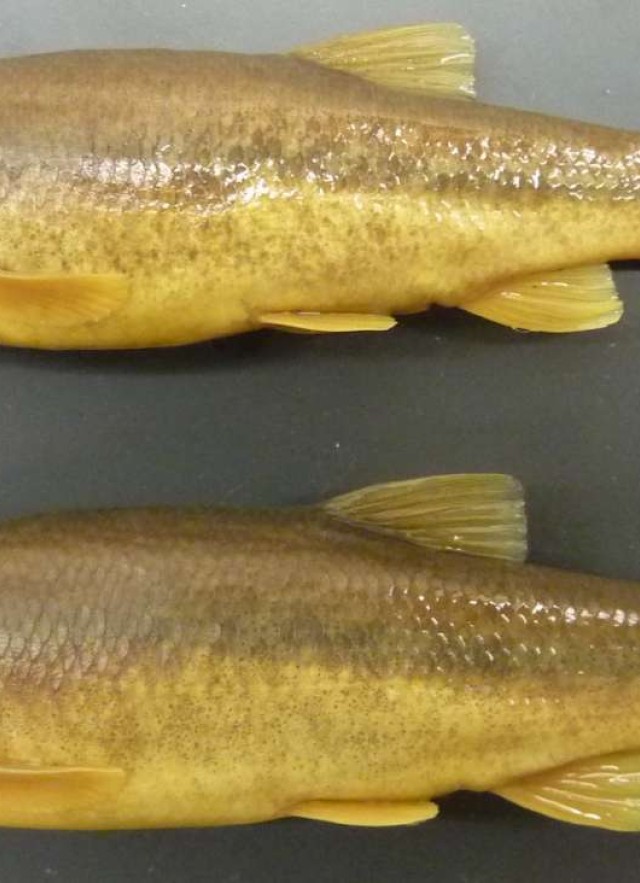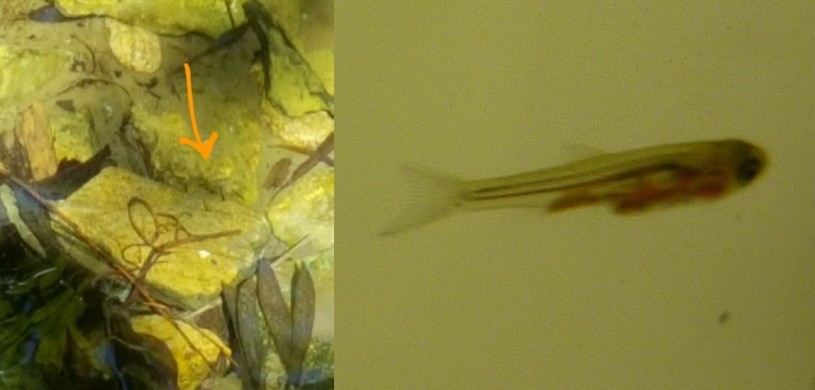The museum will be closed Thursday, January 1 for New Year's Day. We will reopen Friday, January 2.
Summer of Chub
As the days get warmer, the chubs start to appear.

Originally published June 14th, 2016
Just in time for summer, baby Arroyo chub have hatched in our Nature Garden pond! Sharp-eyed Will Hausler from live animal programs spotted dozens of tiny black fish darting around in the shallows at one end of the pond. He shared his discovery with Leslie Gordon, our live animal programs manager, who arranged the chub introduction and has been keeping tabs on them.

Her first thought was that they must be the offspring of the chub we released in March, but she wasn’t sure. It’s hard to tell what kind of fish you’re looking at when you only see it from above, especially if it’s tiny and fast. So I got to pull out my aquarium nets and go do some field work just steps from my office! The little guys were indeed zippy, but I captured one and confirmed the identification: definitely baby Arroyo chub (Gila orcutti). The adult chub are very elusive and rarely seen, and we were unsure whether or not they liked their new home. Confirmation that they are breeding is very good news, because it means they are thriving and have found places to spawn in the vegetation.
Arroyo chub are a kind of minnow, and they are one of Los Angeles’ few native freshwater fishes. They only live here in Southern California, where they are classified as threatened. Urbanization has reduced Arroyo chub populations in the Los Angeles, San Gabriel, and Santa Ana rivers, where they were once common. The amazing thing about chub is how well-adapted they are to our natural cycle of hot, dry summers and occasional floods in rainy winters. Before the rivers were channelized with concrete, they would overflow their banks in years of heavy rain, and spread in wide puddles across the flatlands. These intermittent floods were a fantastic opportunity for Arroyo chub, allowing them to move between our rivers and creeks, mix, and even found new populations. For a fish, dispersing like that is a big gamble, and chub are experts at it because they can tolerate tough conditions like wide variations in water temperature and low oxygen levels.
They will eat any tiny thing they can get, mostly insects and algae. They are also great at controlling mosquitos by eating their larvae, which is why we brought them into our pond in the first place.

The ways that animals move and invade new habitats are things we think about a lot here at the Museum. We study many species of lizards, frogs, snails, spiders, squirrels and insects that have come from somewhere else and made a home in Los Angeles. These new arrivals have to contend with different environments, food, and predators than they are used to, and many don’t survive. The ones that do tend to be generalists, easygoing about tolerating various environments and the food and conditions they find there. Our chub are natives here, but they share those same characteristics, making them tough invaders and good adapters to new habitats. When they get to a new place, they can quickly reproduce and increase their numbers, which is exactly what they’ve done in our Nature Garden.